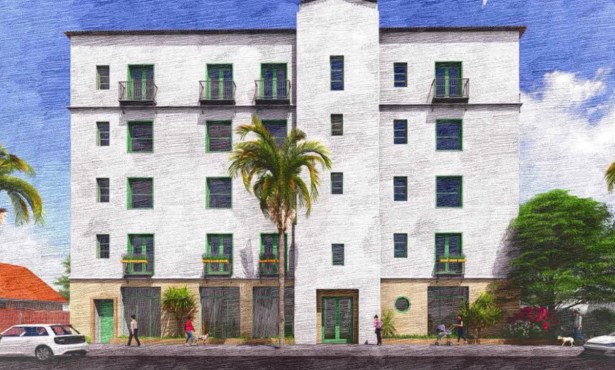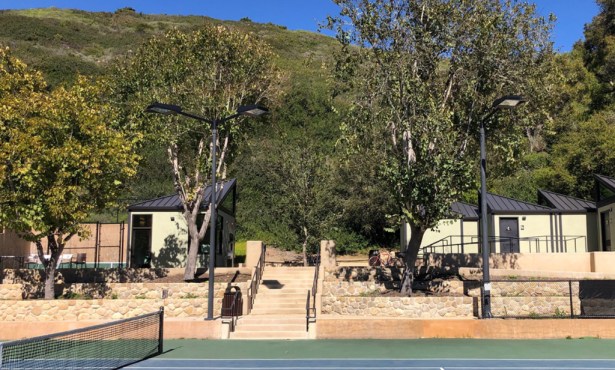The Missions in Art
From San Juan Capistrano to Taco Bell — and Back
by Charles Donelan
From the gated George Washington Smith mansions of Hope Ranch
and Montecito to the Taco Bell logo on the wrapper of last night’s
chicken gordita, mission style and symbolism saturate Santa Barbara
and all of California, providing a kind of aesthetic template for
the architecture and imagery of the entire state. From a practical
point of view, the resounding triumph of mission style here makes
sense — the white walls, red-tiled roofs, and simple, dramatic
arches work exceedingly well in our natural landscape. Because it
is so widespread, an influence like the mission motif can be easily
taken for granted. Yet the historical origins of our dominant
California Spanish style remain intriguing, not only because of the
Spanish colonial missionaries themselves, but also through the
fascinating stories of the artists and patrons who, despite their
distance from the original padres, have still taken the missions to
heart. In its most widespread manifestation as a style, the story
of the missions is the story of those who loved them, what they saw
in them, and why.
Through September 30, Sullivan Goss Gallery in Santa Barbara
will be displaying The Missions and Early California Buildings, an
exhibit of artwork both historical and recent that reflects the
continuing fascination of fine artists with this subject. There is
no better way to explore the multiple meanings and deep emotional
resonance of the missions than through art. By examining these
images, informed viewers cannot only see, but also feel how the
missions have transcended any single category of aesthetic
influence. Mission style in California has become a kind of second
nature, a fluid and dynamic aesthetic force that shapes our lives
nearly as thoroughly as its natural counterparts — air, water, and
sunshine.
The artist Henry Chapman Ford arrived in Santa Barbara from
Chicago in the early 1880s, just in time for the original great
mission revival. Ford made the first complete set of etchings of
all the missions of California in 1883, one year before the
publication of Helen Hunt Jackson’s Ramona, the romance novel that
is usually credited with founding California’s “old Spanish days”
fixation. Looking at Ford’s work today, we see the missions in
ruins and immediately learn an important fact — our old Spanish
days were born old. It was only when the missions lay in ruins that
they became interesting to the world at large. Demand for the
California mission style built steadily toward a peak of popularity
in the 1920s, when artists and architects realized that it was
highly compatible with early modernism and other more eclectic
influences. George Washington Smith enthused about the way the
mission style freed him to deviate from the formal vocabulary of
existing architectural tradition, and incorporate primitive masses
and expressionistic shadows into his designs. To see how modernism
influenced what artists made of the missions, compare Nell Brooker
Mayhew’s Tiepolo-like monotypes of 1914 and 1915 to the “Santa
Barbara Mission” in oil by Emil Kosa from 1925. Mayhew’s clear
linear verticals are rendered in a highly legible black, while
Kosa’s implied verticals emerge from within a pulsating grid of
shifting painted planes in the manner of Paul Cezanne.
There is no one true mission style, but rather a harmony of
elements — primitive and sophisticated, sacred and secular — that
are combined most effectively in the best examples. Some uses of
mission iconography are hard to spot because they are hidden in
plain sight. For instance, we can all agree that the Taco Bell is a
mission icon, but what about McDonald’s golden arches? In the
repeated yellow curves of Robin Gowen’s 2006 painting “Mission
Nocturne,” the familiar bell appears to share the space of the
mission tower with a hint of that world-famous letter “M” logo.
Even if you aren’t buying the mission/Mickey D’s connection, you
may still find these great paintings of actual missions sensitize
you to the more subtle remnants of the mission motif hidden in our
contemporary culture.
Finding the meaning of mission style offers more challenges than
simply recognizing its pervasiveness. Again, the fine arts are,
along with history and imagination, our most valuable guides.
Angela Perko’s 2006 cubist work “Santa Barbara Mission with Palms”
harmonizes the pose of a single woman in blue with the multiple
crosses that adorn the structure she inhabits. The hands she clasps
in front of her (perhaps in prayer?) form the intersection of
horizontal and vertical that enlists her in the picture’s community
of symbolic forms.
Most of these images present the missions without visible human
figures, hearkening back to the original revival’s experience of
them as abandoned ruins. From a psychological point of view, these
unpopulated landscapes imply the isolation of the viewer, who, as
witness to the empty scene, becomes the only certain human
presence. Equally alone are the endangered Native Americans, who
must have felt that the world they knew — and the world that knew
them — was vanishing more rapidly than even they could comprehend.
What must these mission buildings have looked like to those for
whom they were the first Western architecture of any kind that they
had ever seen?
This is why it is worth taking time to look again at the icons
of the mission and its images in art — so that, in the words of
Willa Cather, “Our eyes can see and our ears can hear what is there
about us always.”
4•1•1 The Missions and Early
California Buildings will be on display at Sullivan Goss, An
American Gallery, 7 East Anapamu Street, through October 4.


